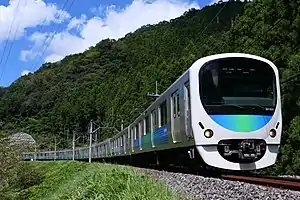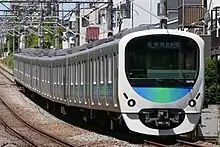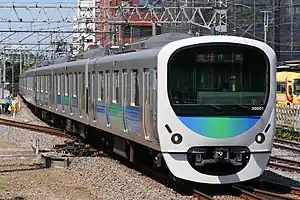Seibu 30000 series
The Seibu 30000 series (西武30000系) is an electric multiple unit (EMU) train type operated by the private railway operator Seibu Railway on commuter services in the Tokyo area of Japan. First introduced in April 2008, a total of six 10-car sets, eighteen 8-car sets, and six 2-car sets were built by Hitachi between 2008 and 2016 to replace older three-door 101 series and 301 series sets.[1] It is nicknamed the "Smile Train" (スマイルトレイン, Sumairu Torein).[2]
| Seibu 30000 series Smile Train | |
|---|---|
 Seibu Railway 30000 series 8-car set 38105 in September 2019 | |
| In service | 2008–present |
| Manufacturer | Hitachi |
| Built at | Kudamatsu, Yamaguchi |
| Family name | Hitachi A-train |
| Replaced | 101 series, 301 series |
| Constructed | 2008–2016 |
| Entered service | April 2008 |
| Number built | 216 vehicles (30 sets) |
| Number in service | 216 vehicles (30 sets) |
| Formation | 2/8/10 cars per trainset |
| Operator(s) | Seibu Railway |
| Depot(s) | Kotesashi, Minami-Iriso, Musashigaoka, Tamagawa-Josui |
| Line(s) served | |
| Specifications | |
| Car body construction | Aluminium |
| Car length | 20,000 mm (65 ft 7 in) |
| Width | 2,930 mm (9 ft 7 in) |
| Doors | 4 pairs per side |
| Maximum speed | 105 km/h (65 mph) |
| Acceleration | 3.3 km/(h⋅s) (2.1 mph/s) |
| Electric system(s) | 1,500 V DC |
| Current collector(s) | overhead catenary |
| Track gauge | 1,067 mm (3 ft 6 in) |
Design
Sets are formed as two-, eight-, and ten-car units, consisting of aluminium wide-bodied (2.93 m (9 ft 7 in)) 20 m (65 ft 7 in) long four-door cars with no end gangway doors.[2] Six-car sets were also scheduled to be built by fiscal 2011, but none were ultimately delivered.[1][3]
Fleet
As of 10 November 2021, the fleet consists of 6 ten-car sets, 18 eight-car sets, and six two-car sets, based at Kotesashi, Minami-Iriso, Musashigaoka, and Tamagawa-Josui depots for use on Seibu Shinjuku Line and Seibu Ikebukuro Line workings.[3][4]
The last set ordered, eight-car set 38118, was delivered in June 2016, bring the total size of the fleet to 216 vehicles (30 sets).[4]
Formations
Sets are formed as shown below.[3]
2-car sets
The six 2-car sets, numbered 32101 to 32106, are formed as follows, with car 1 at the Hanno end.
| Car No. | 1 | 2 |
|---|---|---|
| Designation | Mc | Tc |
| Numbering | 32100 | 32200 |
- The Mc cars are equipped with two single-arm pantographs.[3]
8-car sets
The eighteen 8-car sets, numbered 38101 to 38118, are formed as follows, with car 1 at the Hanno end.
| Car No. | 1 | 2 | 3 | 4 | 5 | 6 | 7 | 8 |
|---|---|---|---|---|---|---|---|---|
| Designation | Tc1 | M1 | M2 | T1 | T3 | M5 | M6 | Tc2 |
| Numbering | 38100 | 38200 | 38300 | 38400 | 38500 | 38600 | 38700 | 38800 |
- The M1 and M5 cars are each equipped with one single-arm pantograph.[3]
10-car sets
The six 10-car sets, numbered 30101 to 30106, are formed as follows, with car 1 at the Hanno end.
| Car No. | 1 | 2 | 3 | 4 | 5 | 6 | 7 | 8 | 9 | 10 |
|---|---|---|---|---|---|---|---|---|---|---|
| Designation | Tc1 | M1 | M2 | T1 | M3 | T2 | T3 | M5 | M6 | Tc2 |
| Numbering | 30100 | 30200 | 30300 | 30400 | 30500 | 30600 | 30700 | 30800 | 30900 | 30000 |
- The M1 and M6 cars are each equipped with one single-arm pantograph.[3]
Interior
Seating consists of longitudinal bench seating throughout. Wheelchair spaces are provided in the two outermost cars at each end of eight-car sets and in the 32100 cars of two-car sets.[3] Priority seats are provided at the end of each car.[3] Sets built from fiscal 2013 feature LED lighting and transparent overhead luggage racks in place of the earlier stainless steel pipe racks.[5]
Batches 1–6
 Interior view, January 2014
Interior view, January 2014 General seating, January 2014
General seating, January 2014 Priority seating, January 2014
Priority seating, January 2014 Wheelchair space and vestibule, January 2014
Wheelchair space and vestibule, January 2014 Ceiling dome, January 2014
Ceiling dome, January 2014 LCD passenger information display, January 2014
LCD passenger information display, January 2014
Batches 7–10
 Interior view, January 2014
Interior view, January 2014 General seating, January 2014
General seating, January 2014 Priority seating, January 2014
Priority seating, January 2014 Vestibule, January 2014
Vestibule, January 2014 Ceiling dome, January 2014
Ceiling dome, January 2014 LCD passenger information display, January 2014
LCD passenger information display, January 2014
History
The first train entered service on the Seibu Shinjuku Line on 26 April 2008.[6]
Livery variations
Doraemon
From 8 October 2020, eight-car set 38101 was operated with an all-over Doraemon-themed wrap. The sides are blue; some doors resemble Doraemon, and others are plain, in line with the rest of the body. The interior is also Doraemon-themed.[7]
 Set 38101
Set 38101
Interior
 Interior view, May 2021
Interior view, May 2021 Priority seating, May 2021
Priority seating, May 2021 Wheelchair and stroller space, May 2021
Wheelchair and stroller space, May 2021 Door view, May 2021
Door view, May 2021
Fleet history
The fleet history details are as shown below.[3]
2-car sets

| Batch | Set No. | Date delivered |
|---|---|---|
| 2 | 32101 | |
| 32102 | ||
| 32103 | ||
| 6 | 32104 | 2 November 2012 |
| 32105 | 19 November 2012 | |
| 32106 | 10 December 2012 |
8-car sets

| Batch | Set No. | Date delivered |
|---|---|---|
| 1 | 38101 | |
| 38102 | ||
| 38103 | ||
| 2 | 38104 | |
| 38105 | ||
| 3 | 38106 | |
| 38107 | ||
| 4 | 38108 | |
| 38109 | ||
| 5 | 38110 | |
| 38111 | ||
| 6 | 38112 | 2 November 2012 |
| 38113 | 19 November 2012 | |
| 38114 | 10 December 2012 | |
| 7 | 38115 | 23 December 2013 |
| 8 | 38116 | 1 December 2014 |
| 9 | 38117 | 19 January 2016 |
| 10 | 38118 | June 2016[4] |
10-car sets

| Batch | Set No. | Date delivered |
|---|---|---|
| 7 | 30101 | 23 December 2013 |
| 30102 | 24 December 2013 | |
| 8 | 30103 | 27 October 2014 |
| 30104 | 17 November 2014 | |
| 9 | 30105 | 14 October 2015 |
| 30106 | 26 October 2015 |
References
- "西武鉄道30000系" [Seibu 30000 series]. Tetsudō Daiya Jōhō Magazine. Vol. 36, no. 278. Japan: Kōtsū Shimbun. June 2007. p. 75.
- 私鉄車両年鑑2012 [Japan Private Railways Annual 2012]. Tokyo, Japan: Ikaros Publications Ltd. February 2012. p. 185. ISBN 978-4-86320-549-9.
- 私鉄車両編成表 2016 [Private Railway Rolling Stock Formations - 2016] (in Japanese). Japan: Kotsu Shimbunsha. 25 July 2016. pp. 50–51. ISBN 978-4-330-70116-5.
- 西武30000系38118編成が甲種輸送される [Seibu 30000 series set 38118 delivered]. Japan Railfan Magazine Online (in Japanese). Japan: Koyusha Co., Ltd. 12 June 2016. Archived from the original on 13 June 2016. Retrieved 13 June 2016.
- 2013年度 鉄道事業設備投資計画 [Fiscal 2013 Railway Business Infrastructure Investment Schedule] (PDF). News Release (in Japanese). Japan: Seibu Railway. 16 May 2013. pp. 4–5. Archived from the original (PDF) on 12 June 2013. Retrieved 23 October 2013.
- 新型通勤車両30000系(スマイルトレイン)が4月26日(土)より新宿線にて営業運転を開始いたします。 [New 30000 series "Smile Train" commuter train to enter service on Shinjuku Line from 26 April] (PDF). News Release (in Japanese). Japan: Seibu Railway. 24 March 2008. Archived from the original (PDF) on 30 December 2008. Retrieved 25 June 2012.
- "未来に向かって出発進行!~ドラえもん 50 周年記念~ 「DORAEMON-GO!」運行開始!!" [Departure progress for the future! Doraemon 50th Anniversary ~ "DORAEMON-GO!" Operation starts!!] (PDF) (Press release) (in Japanese). 20 September 2020. Retrieved 30 December 2021.
External links
- Seibu 30000 series train information (in Japanese)
- Seibu 30000 series (Japan Railfan Magazine Online) at the Wayback Machine (archived 25 May 2013) (in Japanese)
